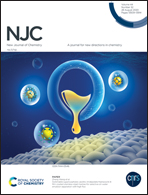1,8-Diazabicyclo[5.4.0]-undec-7-ene based protic ionic liquids and their binary systems with molecular solvents catalyzed Michael addition reaction†
Abstract
Michael addition reaction between acetylacetone and 2-cyclohexene-1-one has been investigated using two protic ionic liquids (PILs), 1,8-diazabicyclo[5.4.0]-undec-7-ene-8-ium hydroxide ([HDBU]OH) and 1,8-diazabicyclo[5.4.0]-undec-7-ene-8-ium acetate ([HDBU]CH3COO) and their binary systems with molecular solvents, water, 1,8-diazabicyclo[5.4.0]-undec-7-ene (DBU), and acetic acid, over a wide range of compositions (XDBU ranging from 0 to 1.0) without using any volatile organic solvent. Kinetic results have been compared with those for the bases DBU and NaOH as catalysts. Neutralization of the organic super-base, DBU with weak acids, water and acetic acid gave the PILs and the formation of PILs was established by thermogravimetric analysis (TGA) and spectral measurements using Fourier transform infrared (FTIR), 1H NMR and 13C NMR. The change in the conductivity and the degradation temperature with composition of the binary systems of the PILs correlated well with the average reaction rate of the Michael addition reaction for the corresponding composition. The comparatively smaller and more nucleophilic anion OH− accelerated the reaction markedly compared to the CH3COO− ion. The better catalytic performance of the ionic liquids and their binary systems compared to the organic base and NaOH for the reaction has been explained with the mechanism of the Michael addition reaction with regard to molecular interactions.
![Graphical abstract: 1,8-Diazabicyclo[5.4.0]-undec-7-ene based protic ionic liquids and their binary systems with molecular solvents catalyzed Michael addition reaction](/en/Image/Get?imageInfo.ImageType=GA&imageInfo.ImageIdentifier.ManuscriptID=D0NJ03012K&imageInfo.ImageIdentifier.Year=2020)


 Please wait while we load your content...
Please wait while we load your content...